As I type this, we are in the middle of the COVID-19 global pandemic. Over the next couple months, I’ll be releasing a set of content and tools that I hope will help people and companies deal with the challenges ahead. I’ve decided to start with this Product Competency Toolkit because it provides a foundation for how PM’s can approach their careers and how companies can think about maximizing the impact of their product teams. I cover these areas in more detail under the section Putting the Competencies into Practice. Stay well – Ravi.
Years ago, I met an early PM at Microsoft who had helped develop what we think of as Product Management today. She started at Microsoft in the mid-1990s. At that time, the PM role was in its infancy, but its importance was already clear. She told new PMs at Microsoft: “You are like the mortar in a brick wall.” Like mortar, you must fluidly fill the gaps between the bricks to make the whole wall stronger.
This analogy resonates even more today. Product Management is a fluid, connective role. It is highly demanding and varies considerably by the situation and from company to company.
The best PMs — the peak product managers — don’t just ship features. They do whatever it takes to deliver valuable outcomes for their users, their team, and their company. They do whatever it takes to deliver business impact.
Product Managers are like the mortar in a brick wall. Like mortar, they must fluidly fill the gaps to make the whole team stronger.
The fluidity of the PM role means that it can be hard to define what traits make a PM successful. At TripAdvisor, we found that the strongest PMs are intellectual athletes who excel at a diverse, mutually reinforcing set of skills.
We codified those skills into 12 competencies organized into four areas that are critical to driving business impact: Product Execution (the ability to build exceptional products), Customer Insight (the ability to understand and deliver on customer needs), Product Strategy (the ability to drive business impact via product innovation), and Influencing People (the ability to rally people around the team’s work).
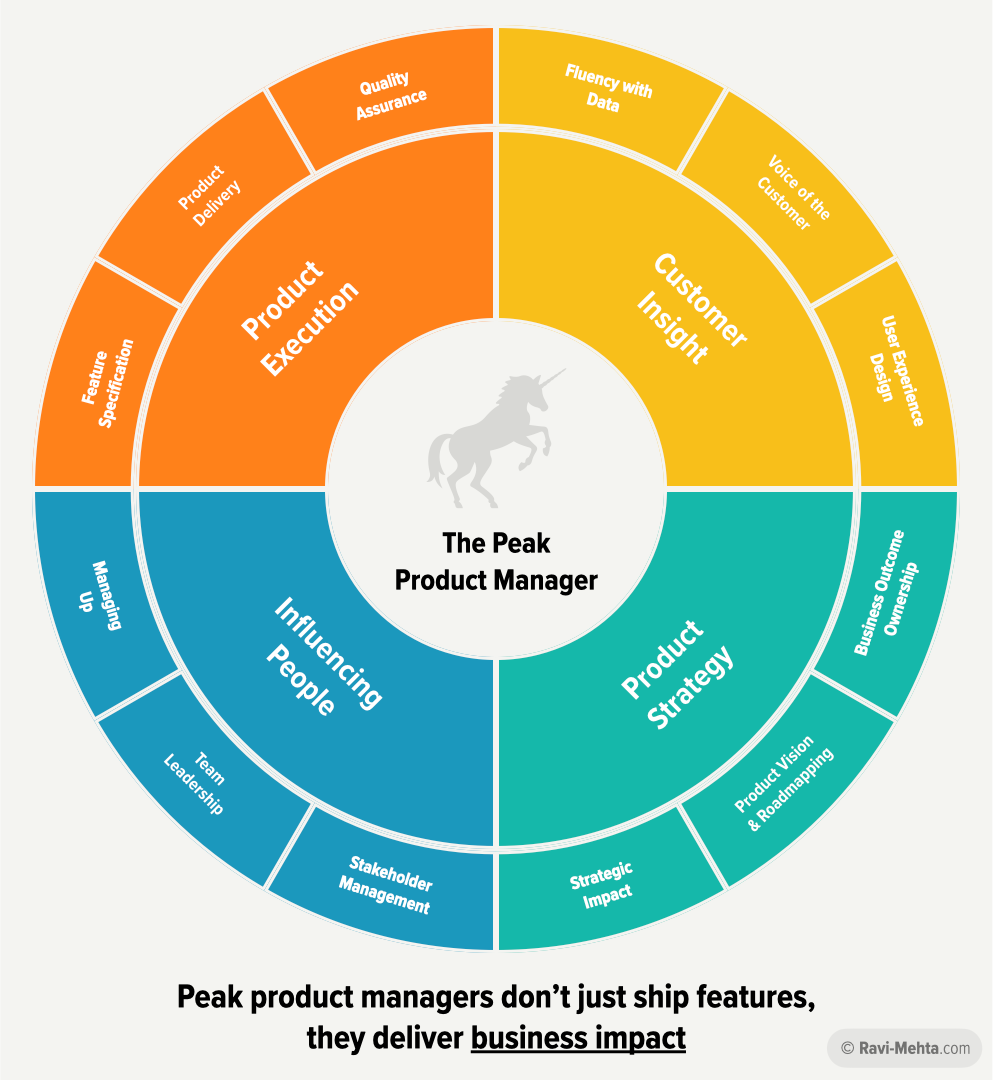
These 12 competencies are as close as I’ve found to a mutually exclusive, collectively exhaustive (MECE) definition of product management.
There is a lot to master, and there are points of tension in the PM role. It is a role that requires people to be simultaneously empathetic and analytical. Qualitative and quantitative. It requires fastidious attention to detail and grand, abstract thinking. The best PMs are both creative innovators and rigorous optimizers.
Most PMs, even peak PMs, excel at only a handful of these competencies. The difference between the average PM and the peak PM is an understanding of gaps and the ability to unite a team that fills those gaps.
The importance of each competency evolves as a PM becomes more senior. Product Execution is a critical area of competency early in a PM’s career. As a PM leader becomes more senior, Product Strategy and Influencing People become the critical path to growth.
The best PMs — the peak product managers — don’t just ship features. They do whatever it takes to deliver valuable outcomes for their users, their team, and their company. They do whatever it takes to deliver business impact.
Let’s dive into each of the 12 competencies of peak product managers and learn how you can join their ranks:
Product Execution
The foundation of successful product management is the ability to work with a cross-functional team to define, build, and launch well-designed, stable products. Peak PMs strive to execute flawlessly. They know there is already enough risk in understanding customer needs and crafting the strategy around those needs. They can’t afford unforced errors.
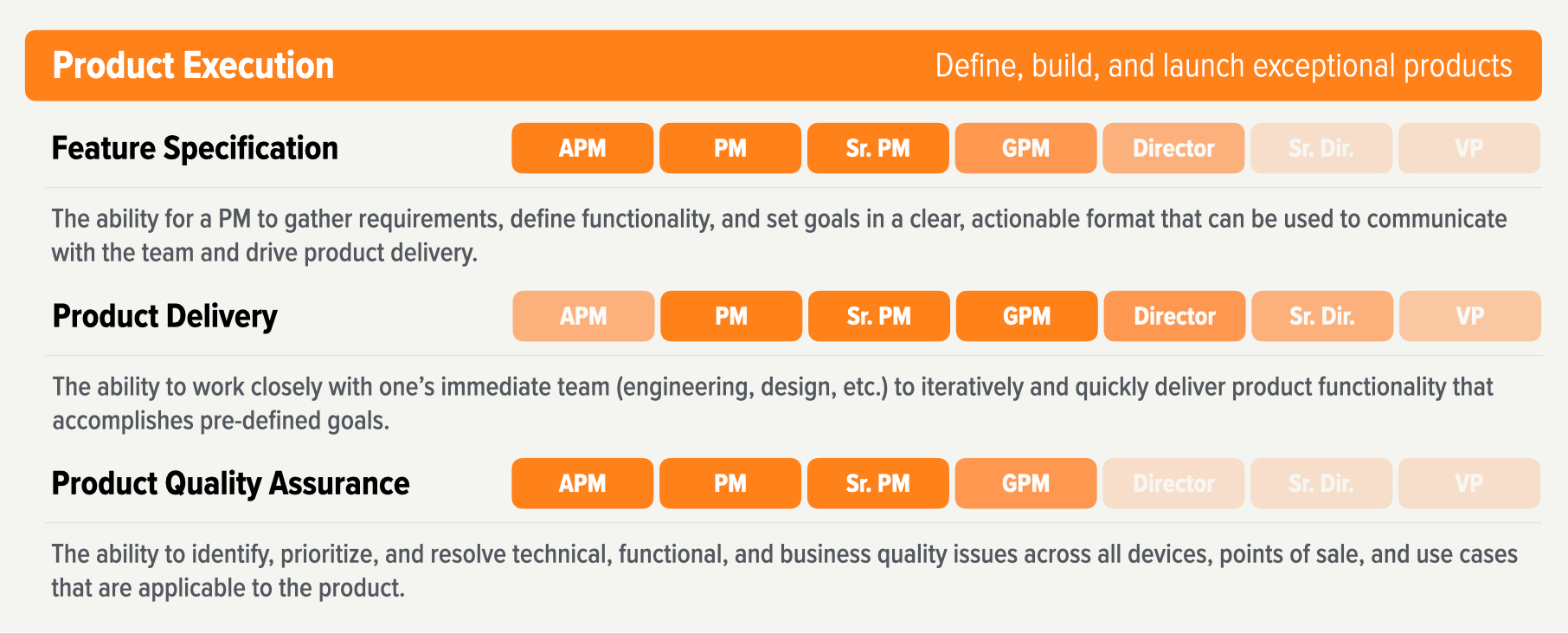
Feature Specification
The ability for a PM to gather requirements, define functionality, and set goals in a clear, actionable format that can be used to communicate with the team and drive product delivery.
Flawless execution starts here. Success flows from a PM’s ability to clearly communicate what the team needs to build and why. A good feature spec does not need to be a lengthy doc — in fact, it probably shouldn’t be. Great specs can be found in JIRA tickets and Slack channels. A PM at TripAdvisor once presented a spec written on a napkin. No matter what form it takes, a good spec rallies the team around a goal and provides enough detail for the team to execute flawlessly.
Product Delivery
The ability to work closely with one’s immediate team (engineering, design, etc.) to iteratively and quickly deliver product functionality that accomplishes pre-defined goals.
Next, PMs need to work effectively with their teams to turn good specs into working products. This requires a critical combination of organizational skills, leadership savvy, attention to detail, and willingness to adapt. The highest performing teams work quickly — they know that speed wins. They work iteratively — they learn more every day and they adapt based on that learning to deliver the best product.
This way of working is exhilarating, but it can also be chaotic. High performing teams ship quickly because they have a frame of reference and work against pre-defined goals. They keep themselves honest about what they set out to achieve and whether they achieved it.
Quality Assurance
The ability to identify, prioritize, and resolve technical, functional, and business quality issues across all devices, countries, and use cases that are applicable to the product.
Quality is your product’s most important feature. Yet, for many companies — maybe even most companies — quality comes last on a long list of “priorities”. The reason is clear.
Quality improvements don’t move metrics in the sexy, easily attributable way that executives like to see. Instead, poor quality is a slow, simmering issue. It eats away at customer delight, trust, and loyalty. Poor quality may not drive your customers away today, but it will make them switch in a hurry when a better competitor comes along tomorrow.
At Spotify, quality comes first. Product managers only work on new features when the quality work is done. You can see this philosophy in their product, can’t you? Can you remember the last time Spotify got in the way of your listening experience?
Customer Insight
Product managers are cultural ambassadors for their customers. They understand customer needs and they represent those needs to the rest of the team. The very best PMs go a step further. They empathize with the people their product serves, and they care deeply about whether that product improves people’s lives.
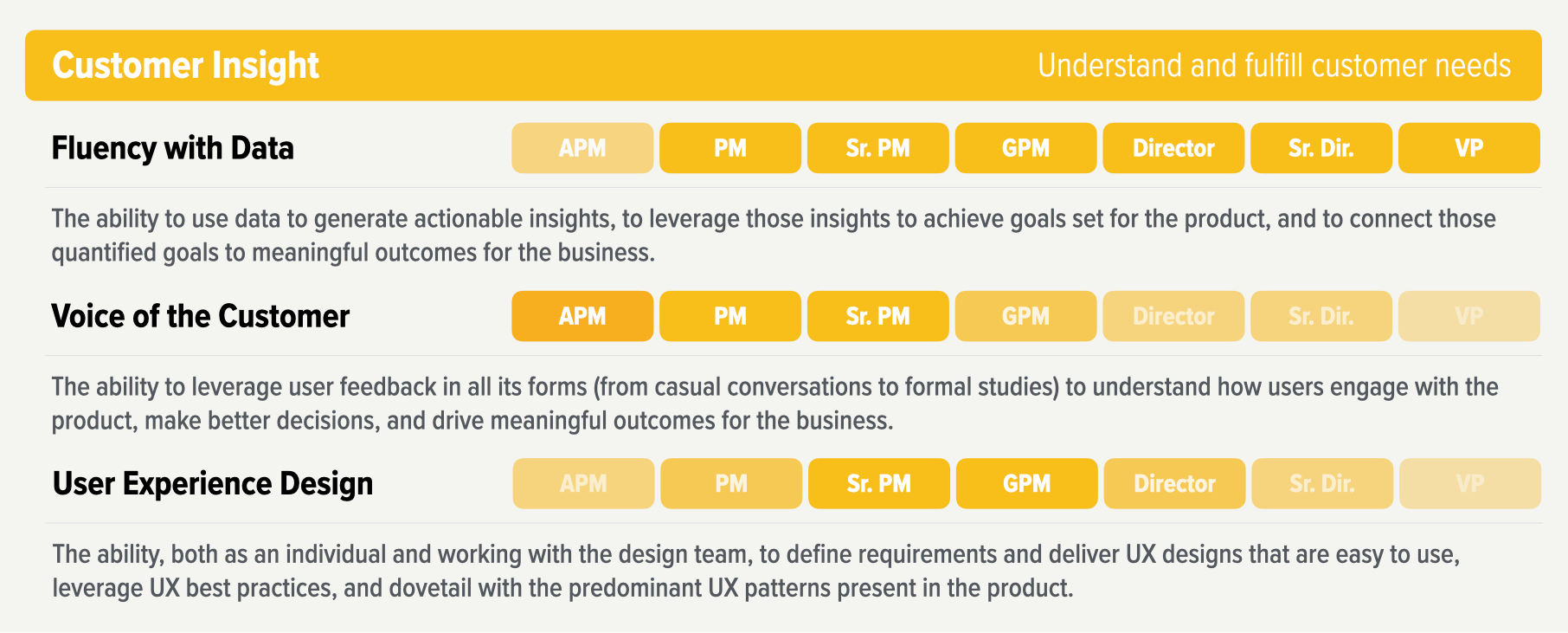
Fluency with Data
The ability to use data to generate actionable insights, to leverage those insights to achieve goals set for the product, and to connect those quantified goals to meaningful outcomes for the business.
Peak PMs think about data differently than the average PM. Too many PMs think their job ends at reporting results. The best PMs dig deep to understand the "why" behind the trends they are seeing in metrics. They translate reporting into actionable learnings, and they use those learnings to guide iterative product development.
Most of all, Peak PMs obsessively seek out the causal relationships between user behavior and valuable outcomes. They use that understanding to evolve the product and grow the business.
Voice of the Customer
The ability to leverage user feedback in all its forms (from casual conversations to formal studies) to understand how users engage with the product, make better decisions, and drive meaningful outcomes for the business.
Data is an incredibly powerful tool to describe customer behavior, but it often falls short of explaining why customers behave the way they do. The only way to truly understand and empathize with customers is to talk to them.
In the early days, startups don’t have much data. They rely on a close relationship with customers to make good product decisions. At small companies, product managers will often chip in by answering support requests or participating in forums. As companies grow, those informal channels start to formalize and user research can become costly, slow, and unwieldy.
As a result, the close relationship with customers starts to atrophy, and PMs over-rely on easily accessible data to make decisions. This leads to misunderstanding customer needs or, worse, optimizing for the company’s goals (which are easier to measure) instead of customer needs.
Peak PMs know that talking to customers is indispensable to making great products, and they understand that effective user research doesn’t need to be slow or costly. They approach user research creatively and they foster a close relationship with customers through multiple channels: casual conversations, customer support tickets, app reviews, surveys, usability tests, focus groups, co-creation sessions, and any other ways they dream up. For example, TripAdvisor PMs used to jump on the Amtrak train from Boston to New York to have impromptu conversations with travelers mid-trip.
User Experience Design
The ability, both as an individual and working with the design team, to define requirements and deliver UX designs that are easy to use, leverage UX best practices, and dovetail with the predominant UX patterns present in the product.
The average PM writes up a spec and throws it over the wall to the design team to figure out the user experience. Peak PMs know that their job is not just to understand and describe customer needs, but to work closely with design to translate those needs into an easy-to-use experience.
Peak PMs emphasize interaction design as an explicit and critical phase of product development. The goal of interaction design is to make it as easy as possible for customers to achieve their needs through the product.
Too often, teams conflate visual design and interaction design. For example, I can’t count the number of times I’ve seen teams use obscure icons instead of clear labels for product functionality. These icons look pretty and conserve valuable screen real estate, but they add unnecessary friction to a customer’s experience. At TripAdvisor, we saw a 20% increase to a critical metric by substituting an icon-heavy UI with a more affordant user interface.
Product Strategy
In his book, Good Strategy Bad Strategy: The Difference and Why It Matters, author Richard Rumelt draws an important distinction between goal setting and strategy, “Unlike a stand-alone decision or a goal, a strategy is a coherent set of analyses, concepts, policies, arguments, and actions that respond to a high-stakes challenge.”
Product Strategy can be similarly defined. Unlike a stand-alone feature or OKR, good product strategy requires PMs to consistently deliver features that build towards a coherent roadmap that enables a company to achieve its overall strategy. Put another way, Product Strategy is the glue that joins product development and company strategy together.
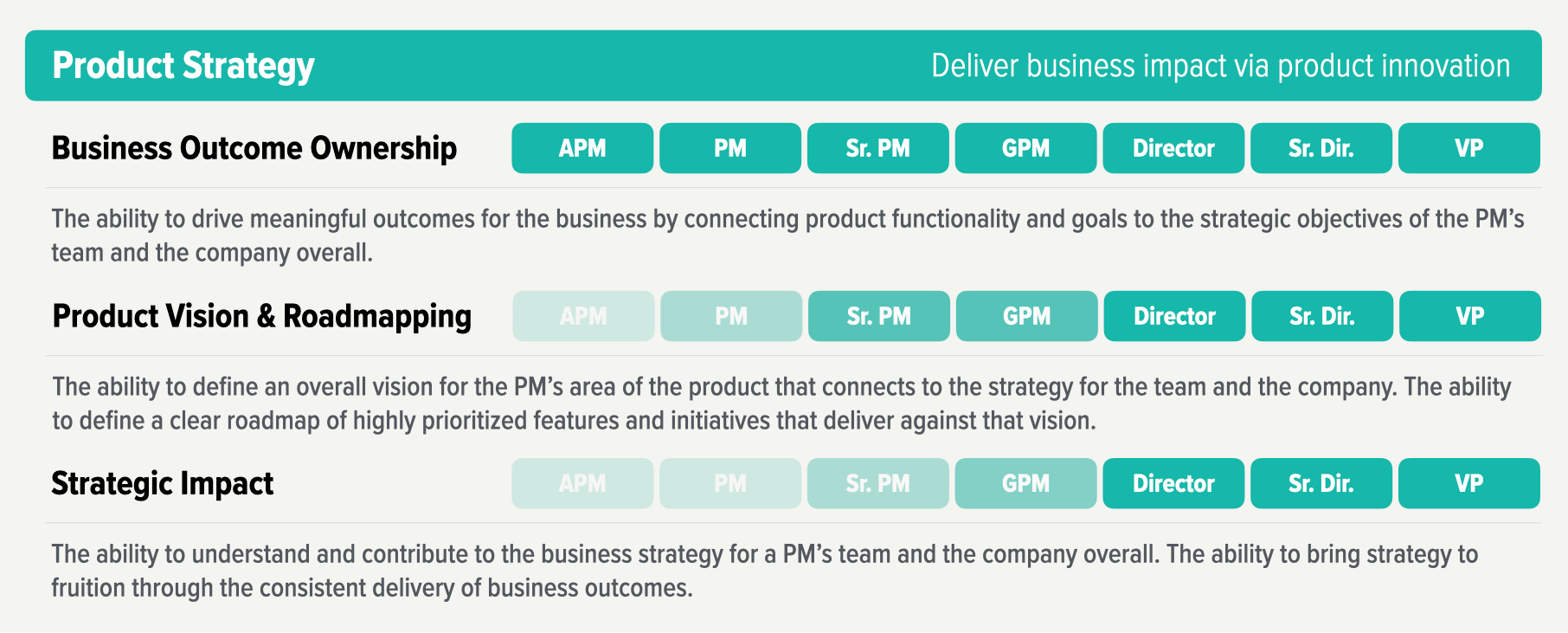
Business Outcome Ownership
The ability to drive meaningful outcomes for the business by connecting product functionality and goals to the strategic objectives of the PM’s team and the company overall.
Above all else, Peak PMs don’t just ship features, they deliver valuable outcomes to the business. For this reason, Business Outcome Ownership is the most important competency for PMs — at all levels of the organization.
The word “ownership” is used deliberately. Peak PMs flock to responsibility for the business, rather than shy away from it. They understand that the product is a means to the end of creating value, not an end in itself. They hold themselves accountable to deliver outcomes over output.
Moreover, peak PMs instill that same sense of ownership in the team, helping the team understand what outcomes they are responsible for delivering, why those outcomes are important, and how they’ll succeed at delivering those outcomes.
Product Vision & Roadmapping
The ability to define an overall vision for the PM’s area of the product that connects to the strategy for the team and the company. The ability to define a clear roadmap of highly prioritized features and initiatives that deliver against that vision.
Early PMs focus on defining a good feature, executing that feature flawlessly, and ensuring the feature solves a customer need and delivers impact to the business.
As PMs get more senior, they need to think about how features connect to each other — how they ladder up to a clear, compelling, cohesive vision for the product. Peak PMs understand how to articulate and build towards that vision. They recognize when to adapt to new information or hold the course. Most of all, they connect the product vision to company strategy so that the product helps the company achieve its goals as the vision comes into being.
Strategic Impact
The ability to understand and contribute to the business strategy for a PM’s team and the company overall. The ability to bring strategy to fruition through the consistent delivery of business outcomes.
TechCrunch maintains a list of products and companies that have been shutdown called The Deadpool. It’s striking how many great products end up in The Deadpool — including many products that users loved. Why do great products get shutdown? Because those products may have provided value to customers, but they didn’t provide value to the companies that created them.
Peak PMs know that product strategy and business strategy are inextricably linked. Successful products are valuable to both the customer and the company. Peak PM’s deliver successful products by understanding what the company’s strategy is designed to achieve. They use the product as a lever to achieve that strategy.
In addition, they provide strategic context to their team — making sure that all decisions, big and small, are aligned. As Peak PMs get more senior, they take a seat at the table with leaders across the business to define strategy. Peak PMs ensure that product strategy is a cornerstone of company strategy.
Influencing People
Lastly, peak PMs know they are only as effective as their team. They view themselves as connective tissue within the organization. They foster strong relationships with cross-functional peers and leadership. As they take on roles of increasing scope and responsibility, they learn how to build and mentor strong PM teams. Peak PMs are able to multiply their impact by enabling the people around them to contribute to and own the business impact necessary to achieve the company’s strategy.
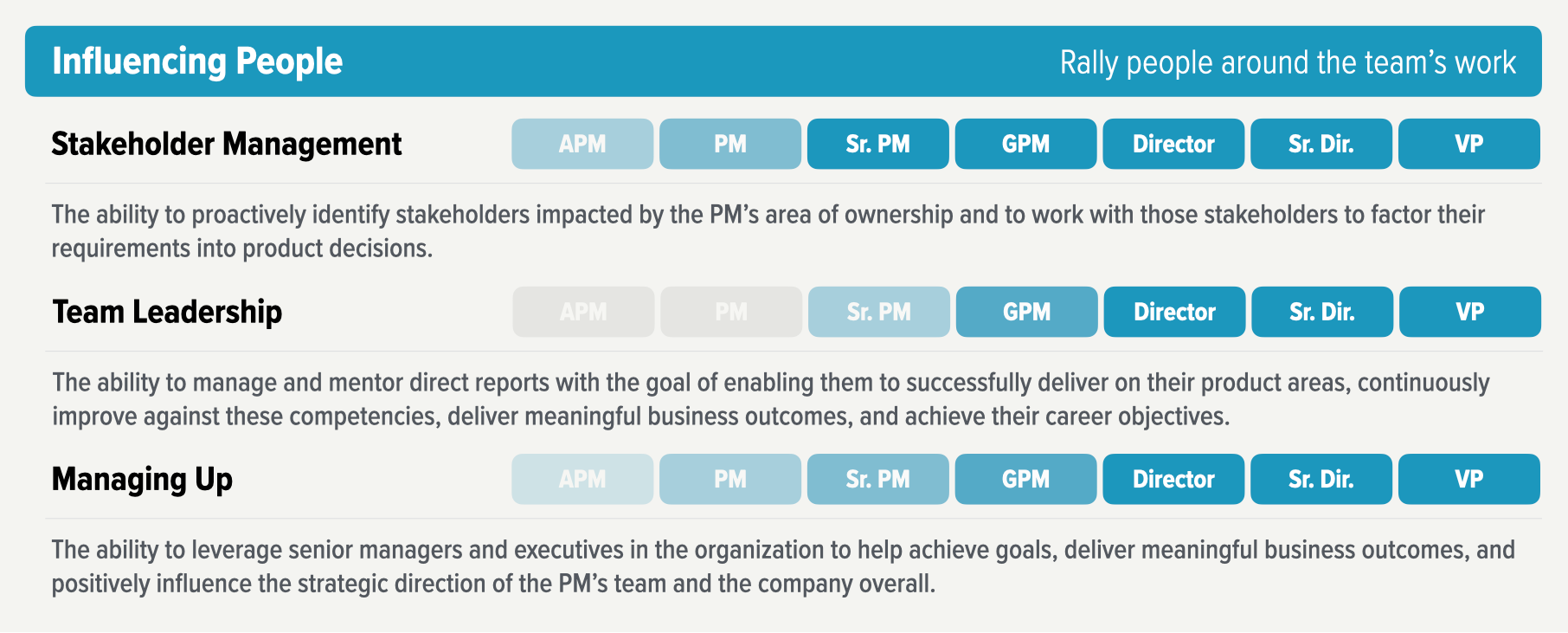
Stakeholder Management
The ability to proactively identify stakeholders impacted by the PM’s area of ownership and to work with those stakeholders to factor their requirements into product decisions.
Product managers at all levels are expected to lead, but they must lead through influence, not authority. This begins with knowing who to engage. I’ve seen many PMs struggle because they didn’t thoughtfully identify stakeholders at the outset.
Once a PM has identified the right stakeholders, they need to form that group into a team. Peak PMs will tap into the best thinking of that team and rally their support. Stakeholders don’t want to be managed as much as they want to be included.
That said, the Peak PM’s job is not to make everyone happy. Compromise is at the root of many bad product decisions. Compromise leads to bloated, difficult to use products. Compromised products cater to the teams who built them, not to the customers who use them. Peak PMs are willing to make the hard product decisions, and they are able to align everyone to those decisions — including the dissenters.
Team Leadership
The ability to manage and mentor direct reports with the goal of enabling them to successfully deliver on their product areas, continuously improve against these competencies, deliver meaningful business outcomes, and achieve their career objectives.
In contrast to many roles, product managers have a significant amount of leadership experience by the time they start to manage their first direct reports. They have had years of practice leading through influence, not authority.
Despite that practice, many new PM leaders fall into the trap of micromanaging their reports. Often, they know the job so well that they don’t make a clear enough distinction between doing and delegating. Sometimes, they overuse the newfound authority they’ve been craving.
Peak PMs see themselves as a coach, first and foremost. They give their direct reports the tools and autonomy to succeed, and they reserve micro-management for cases when performance is lackluster and needs to be improved.
Managing Up
The ability to leverage senior managers and executives in the organization to help achieve goals, deliver meaningful business outcomes, and positively influence the strategic direction of the PM’s team and the company overall.
I look at Managing Up differently than a lot of people. In a well functioning organization, leadership is there to serve you, not the other way around. As Steve Jobs famously said, “It doesn't make sense to hire smart people and tell them what to do; we hire smart people so they can tell us what to do.”
Managing Up is ultimately about getting the support you need to accomplish your goals. This is true regardless of whether your company takes the Steve Jobs approach. Communication is important to Managing Up, but the key is alignment. Peak PMs understand what their boss and other leaders are trying to achieve, and they align their work to those objectives.
Resources flow to the teams who are most aligned with leadership’s objectives.
Putting the Competencies into Practice
The 12 competencies provide a framework you can use to evaluate yourself, your team, and PM candidates. This is particularly important given the challenges we now face as a result of COVID-19. Here are some ways the 12 competencies can help:
- If you are a PM whose job has been impacted, use the competencies as a way to take stock of your skills. This will help you talk to those skills during interviews and may highlight development areas you can work on now. A number of companies have made their coursework free during this time which makes it even easier to grow your skills.
- If you are a product leader, your team and their goals have likely changed significantly. The 12 competencies can help you assess that team and put the right combination of people in place to focus on the new priorities.
- If you are a hiring manager, you face the difficult challenge of making hiring decisions remotely. It’s imperative to standardize on decision criteria, interview questions, interview process, and hiring team to make effective, consistent decisions. The competencies can help you do that.
Each of these areas is covered in more detail below.
Evaluate Yourself
Assess yourself against each of the competencies. Use the competencies to identify your strengths, understand gaps, and chart a course for your growth. You can do this quickly by rating yourself “On Track”, “Over Performing”, or “Needs Focus” on each of the competencies. Generally, you should have 2-3 competencies rated “Over Performing”, 2-3 competencies rated “Needs Focus”, and the rest “On Track”.
Supercharge Your 1-on-1
Before your next 1-on-1 with your manager, spend a few minutes rating yourself “On Track”, “Over Performing”, or “Needs Focus” on each of the competencies. Ask your manager to do the same. Next time you and your manager meet, go through each of the competencies noting where you and your manager see eye-to-eye and where you differ.
Leave the 1-on-1 with one strength you’re going to double down on and one competency that needs focus. This will be one of the most valuable 1-on-1’s you have all year.
Hire Better PMs
Use the competencies to make interviews more comprehensive and standardize how multiple interviewers evaluate the same candidate. It is hard to go through all 12 competencies during a typical 1-2 round interview process. As a result, I recommend having interviewers focus on one of the four competency areas: Product Execution, Customer Insight, Product Strategy, and Influencing People. Collectively, the interviewers will have a comprehensive perspective on the candidate. You can go further by standardizing questions for each competency area and calibrating interviewers to assess the four areas. This will enable you to make better, more consistent hiring decisions.
Make Smarter Promotion Decisions
The product role should evolve considerably as people get more senior. Too often, companies aren’t explicit enough about how expectations change at each level of the product org. They expect PMs to do “more” when they are promoted, but don’t define what that means. The competencies can help.
Prior to making a promotion, rate the candidate “On Track”, “Over Performing”, or “Needs Focus” on each of the competencies. The candidate should be over-performing on most of the competencies to be eligible for the next level and shouldn’t have any critical deficits holding them back. At this point, you’ll be able to make a smarter promotion decision:
- If the candidate isn’t ready for the next level, share your ratings with the person to provide a clear reason why they weren’t promoted and what they need to do to level up.
- If the candidate is ready for a promotion, use your ratings to provide the newly promoted PM a clear picture of expectations at their new level and development areas they must focus on to succeed.
You can use this same approach to do a talent assessment of your whole team. You may find there are PMs that are operating above their level and should be promoted. More likely, you’ll find there are PMs who were promoted without a detailed analysis of their performance and aren’t meeting expectations at their level. Those PMs will need clear guidance on how to close the gap and may need to be re-leveled to bring them closer in line with expectations.
Build More Balanced Teams
Individual PMs are rarely able to excel equally at all of the competencies, yet they are all necessary to ship great products that deliver business impact. The competencies can help you understand the right combination of people to put on a team to make that team successful.
For example, a design-centric PM may excel at an important cluster of competencies necessary to build customer-obsessed products: User Experience Design, Voice of the Customer, and Product Vision & Roadmapping. That same PM may not excel at Fluency with Data. That’s a gap that must be filled — analytics is essential to assessing the impact of any initiative and charting a course towards success.
There are a few different ways to fill this gap. In some cases, you can partner the design-centric PM with a more analytics-oriented PM. More often, you can fill these gaps by teaming the PM with strong, cross-functional partners in analytics, data science, design, engineering, marketing, and other people in the organization.
That brings me to a final point — the peak product manager is an ideal worth striving for, not just as an individual, but as a team and as a company. Great products are the result of talented, complementary teams working together to reinforce each other’s skills. These 12 competencies provide a framework for building those teams and the people who lead them.

